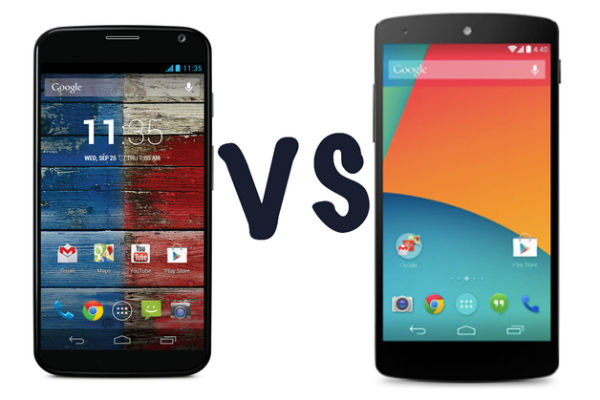Display and Processor Moto X features a 4.7 inch AMOLED capacitive touchscreen display with a HD resolution of 1280 x 720 pixels and a pixel density of 312 pixels per inch and it is protected with Corning Gorilla Glass. In comparison, the LG made Nexus 5 boasts of a slightly larger 4.95 inch True HD IPS+ capacitive touchscreen display packed with FHD 1920 x 1080 pixel resolution resulting in 445 ppi pixel density. Further, the Nexus 5’s screen is topped with the Corning Gorilla Glass 3 protection. Nexus 5 not only packs a FHD resolution screen for improved clarity, but also has IPS display that can offer good viewing angles, enhanced daylight visibility, better color reproduction and sharper images. But, on the other hand, the AMOLED display in the Moto X consumes less power and thereby saves the battery life to a great extent despite offering good clarity. In terms of processor, Moto X comes equipped with a Qualcomm MSM8960Pro Snapdragon chipset with dual-core Krait processor clocked at 1.7 GHz. When it comes to Nexus 5, the device has a Qualcomm MSM8974 Snapdragon 800 chipset coupled with a 2.3 GHz quad-core Krait processor that can help the phone to run smoothly, exhibit better multi-tasking and consume the battery power as well. Camera and Memory The Moto X has a 10 MP rear camera teamed with autofocus and LED flash while the Nexus 5 gets an 8 MP primary camera with improved features such as OIS, autofocus and LED flash. Obviously, Nexus 5 wins our hearts in this segment with OIS as it can capture images and videos with great stability. Also, in the front camera segment, the Nexus 5 comes with a 1.3 MP sensor while its counterpart has a 2 MP front-facer with support to FHD 1080p video recording. On the memory part, both the Moto X and Nexus 5 are on par with each other as they come in two options: 16 GB and 32 GB and feature 2 GB of RAM. However, the memory capacity cannot be expanded externally as the phones do not possess a micro SD expansion slot. With 2 GB RAM, these phones will surely fare well as they can run multiple applications effortlessly. Battery and Features Moto X includes a 2,200 mAh battery rated to provide 13 hours of talk time and 576 hours of standby time, whereas Nexus 5 is fueled by a 2,300 mAh battery delivering 17 hours of talk time and 300 hours of standby time. But, we think the battery in Nexus 5 is small to power the device considering its FHD display and quad-core processor. Moto X runs on Android 4.2.2 Jelly Bean with a promised upgrade to Android 4.4 KitKat while on the other hand, the Nexus 5 is the first device to be announced with the Android 4.4 KitKat and it runs on the version 4.4.2 with increased chances for further upgrades, which the Moto X might miss. In terms of data connectivity, both Moto X and Nexus 5 feature 3G, Wi-Fi, Bluetooth, NFC and 4G that are mandatory in phones these days. Both the phones have USB on-the-go, which is an added advantage as it allows the phone to act as a flash drive with the ability to read all its contents instantly without a computer host. Also, the presence of an additional core in the Nexus 5 allows the processor to save the battery life by utilizing it for handling applicatons thereby minimizing the impact on the battery. Though LG’s Nexus 5 has an upper hand in the hardware front, the Moto X has a plethora of software features including the Active Display. This aspect is similar to Nokia’s Glance Screen and it shows the emails, time, unread messages, notifications and missed calls even when the display is turned off. Also, the pre-loaded Migrate app lets users to transfer data such as videos, photos, contacts and also the call log and text messages from any Android 4.2 based smartphone. Touchless control is a feature that allows to listen to the voice commands of the user without touching the handset. Key Specs Conclusion Both the Nexus 5 and Moto X are capable smartphones with mid-range pricing, but the Nexus 5 is somewhat better than the Motorola offering as it comes with top-tier aspects making its slightly higher pricing acceptable. According to me, the Google Nexus 5 is the best one if you do not mind shedding extra bucks.
